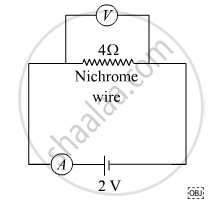Advertisements
Advertisements
प्रश्न
A V-I graph for a nichrome wire is given below. What do you infer from this graph? Draw a labelled circuit diagram to obtain such a graph.

उत्तर

The graph between V & I is a straight line.
So we can conclude that Current flowing through the wire is directly proportional to the potential difference V across it.
The resistance of the wire can be calculated as
`"R" = "v"/1 = 0.4/0.1 = 4Ω`
We can also conclude that nichrome wire has a constant value of the resistance as 4 Ω4 Ω.
nichrome wire follows ohm's law thus it behaves as an ohmic conductor.
The circuit diagram corresponding to the above graph is as shown below.

APPEARS IN
संबंधित प्रश्न
The values of current (I) flowing through a given resistor of resistance (R), for the corresponding values of potential difference (V) across the resistor are as given below:
| V (volts) | 0.5 | 1.0 | 1.5 | 2.0 | 2.5 | 3.0 | 4.0 | 5.0 |
| I (amperes) | 0.1 | 0.2 | 0.3 | 0.4 | 0.5 | 0.6 | 0.8 | 1.0 |
Plot a graph between current (I) and potential difference (V) and determine the resistance (R) of the resistor.
State the relation between potential difference, work done and charge moved.
Why do electricians wear rubber hand gloves while working with electricity?
The values of potential difference V applies across a resistor and the corresponding values of current I flowing in the resistor are given below:
| Potential differences, V (in volts) | : | 2.5 | 5.0 | 10.0 | 15.0 | 20.0 | 25.0 |
| Current, I (in amperes) | : | 0.1 | 0.2 | 0.4 | 0.6 | 0.8 | 1.0 |
A p.d. of 10 V is needed to make a current of 0.02 A flow through a wire. Wire p.d. is needed to make a current of 250 mA flow through the same wire?
What current will be taken by a 920 W appliance if the supply voltage is 230 V?
How is the electric potential difference between the two points defined? State its S.I. unit.
Define the following:
Potential difference
Five resistors of different resistances are connected together as shown in the figure. A 12 V battery is connected to the arrangement.

Calculate:
(i) the total resistance in the circuit
(ii) the total current flowing in the circuit.
A 10 m long wire of a particular material is of resistance 5Ω What will be the resistance if the wire is stretched to double its length?
